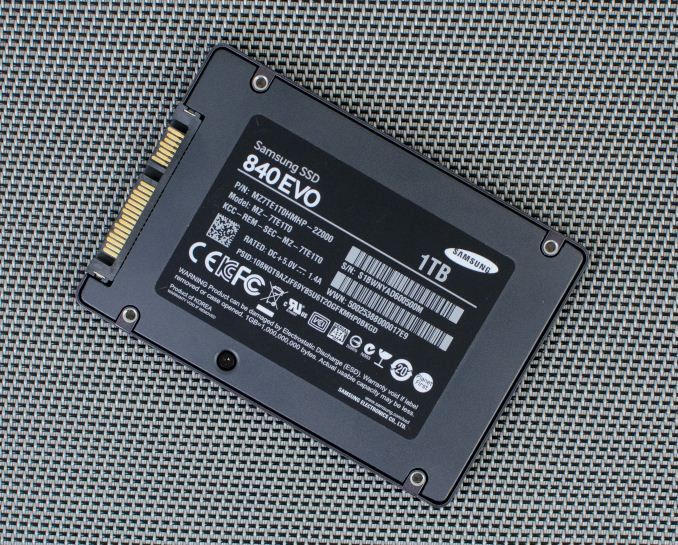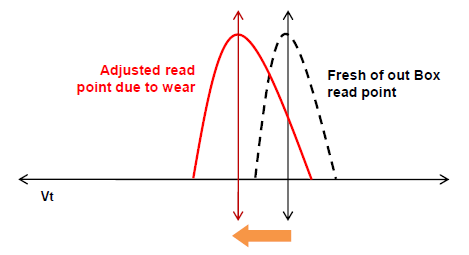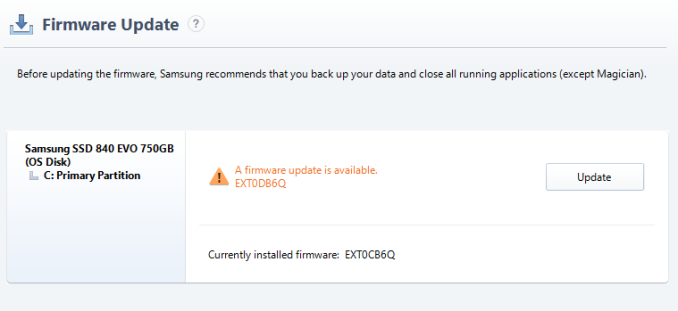Samsung Releases Second 840 EVO Performance Fix
by Ryan Smith on April 27, 2015 6:00 PM EST
If nothing else, the odyssey of Samsung’s 840 EVO has not been lacking in excitement. After initially launching in 2013 to great fanfare as an excellent, strong-performing low-cost drive, over the long run performance regressions began to occur in deployed drives that saw the read performance of old data significantly drop. At the heart of the issue was the drive’s relatively uncommon 19nm TLC NAND, which given the combination of small feature size and tighter requirements of TLC, eventually resulted in the drive having to slow down and re-read cells to properly read the charge-decayed cells.
Aiming to fix the issue, in 2014 Samsung released a performance restoration tool and firmware update for the 840 EVO. The combination of the tool and firmware would update the drive to better handle decayed cells and reduce the need to re-read them, meanwhile the restoration tool would refresh the drive’s data by re-writing all of the data to fresh cells. The idea being that fresh data in combination with the newer firmware would prevent the drive’s performance from decaying again.
Unfortunately that didn’t work out as planned, and while the data refresh from the performance restoration tool did bring drive performance back up, over the long run performance once again began decaying on old data, even with the firmware improvements. As a result Samsung has commissioned a second, more permanent fix for the 840 EVO. This fix involves another firmware update, this time installing a firmware that periodically refreshes old data rather than the one-off refresh of the performance restoration tool. Refreshing the data once again brings performance back up to where it should be, and the periodic, repeating nature of the refresh means that data is never allowed to get too old to let performance degrade again.
Ultimately Samsung’s second fix is a bit of a brute force solution to the problem, but at this point there doesn’t seem to be anything Samsung can do about 19nm TLC cell charge decay other than to refresh the data, as the problem is intrinsic to the NAND itself. Pre-release versions of the firmware show that this fix works, and conceptually this is much more likely to work over the long run than Samsung’s initial fix. The tradeoff is that it does consume P/E cycles to refresh the data, but by our own calculations even 5 years of refreshes at 1/week would only be 26% of the drive’s rated 1000 cycle lifetime. Meanwhile for the longer term, Samsung has since moved on to 3D-VNAND in newer drives, which is more stable than very small geometry planar NAND and essentially turns back the clock on NAND scaling issues. So the 840 EVO should be the last Samsung TLC drive to encounter this issue.
In any case, after previewing the updated firmware to the press, Samsung has released the updated firmware and its associated version of Samsung Magician (version 4.6) to the public over on their website. After an initial staggered release over the weekend – we suspect to make sure not too many users had the firmware if a problem quickly cropped up – Samsung looks to have opened downloads to everyone. However Mac and Linux users will want to note that at this time only the Magician version of the firmware has been released; the bootable ISOs for directly updating the drive have yet to be updated.
In the meantime this will continue to be an issue we keep an eye on. As with the initial problem and Samsung’s first fix, the decay issue only occurs after a time, so we’ll have to see where 840 EVO performance is in a couple months’ time. However with the very nature of the problem and the periodic refreshing of data, we’re hopeful that this will finally put an end to the performance degradation.
Source: Samsung












73 Comments
View All Comments
leexgx - Thursday, April 30, 2015 - link
if you use it in server work loads it could be a problem (which voids the warranty an way as due to amount of data written), normal loads you should easily get 5-10 years out of it, all this fix is doing is making the SSD do what it should've been doing any way, and its Predictable reduction life as well (that trips at around 400TB you can still get about twice that before there are Problems happen)mapesdhs - Tuesday, May 5, 2015 - link
People are being very lenient with Samsung about all this. If this was an issue with an OCZ drive, everyone would be screaming from the rooftops. Very hypocritical IMO.Ian.
OnBoard - Tuesday, April 28, 2015 - link
Well they got something magic in this firmware indeed.Before fix: http://i.imgur.com/omXwIr5.png
Instantly tested after reboot: http://i.imgur.com/TuMKnPJ.png
I think tomorrow my drive will be in full speed without any full drive rewrites.
leexgx - Thursday, April 30, 2015 - link
does look quite good, if you leave the system on long enough it should hopefully resolve itself) you can always run the Optimiser just once so emiedalty corrects the speeds (but really going form 40mb to 300mb/s is good)baii9 - Tuesday, April 28, 2015 - link
"So the 840 EVO should be the last Samsung TLC drive to encounter this issue."The world should not end tomorrow.
trparky - Tuesday, April 28, 2015 - link
It seems that TLC NAND isn't the only type of NAND that's having a problem at process nodes of 19nm of less. The Crucial MX200 SSD which uses 16nm MLC 128Gb NAND flash chips appears to be having the same very issue that the Samsung 840 EVO had, namely NAND flash voltage drifting which causes read speed performance issues on older data.What does this mean? Well, it means that pretty much NAND flash memory becomes unreliable as the process node shrinks past 20nm. NAND flash manufacturers have hit the wall when it comes to planar NAND. From this point on the only way to make NAND flash reliable is to reverse the process node shrinkage and go to 3D-NAND where NAND cells are stacked on one another instead of laid out flat.
Samsung started this trend in which they released their 3D-VNAND and reversed the process shrinkage to 40nm with their 850 line of SSDs. Other manufacturers are also doing the same with their own approach to 3D-NAND. Ultimately it comes down to the fact that NAND flash memory manufacturers have hit the wall in terms of shrinking NAND and that as you shrink the process node the NAND has far more of a chance of voltage drifting that can effect read speed performance as the data ages.
Squuiid - Tuesday, April 28, 2015 - link
I wouldn't go near Crucial's MX series. Their MX100 has serious firmware problems which they still haven't been able to fix and the MX200 is also borked.Their firmware dev team are a joke.
trparky - Tuesday, April 28, 2015 - link
I have one myself, I'm lucky I'm still within the 30-day return policy at Amazon.com. I already have another SSD on the way today and I'm shipping the piece of crap MX200 back to them for a full refund.Gigaplex - Tuesday, April 28, 2015 - link
I've got an MX100 and haven't noticed any issues with it. What serious firmware problems are you referring to?trparky - Wednesday, April 29, 2015 - link
Random BSODs caused by the MX100 dropping off the SATA channel. Read up on the Crucial forums.The fact that they released the MX200 quickly after the release of the original MX100 should tell you something, the MX100 is seriously broken and no amount of firmware fixes will fix the issue with MX100. They should be refunding those people who bought the MX100.